
Anageshna is a monotypic moth genus of the family Crambidae described by Eugene G. Munroe in 1956. Its only species, Anageshna primordialis, the yellow-spotted webworm, was described by Harrison Gray Dyar Jr. in 1907. It is found in the US states of Alabama, Arkansas, Arizona, Florida, Georgia, Iowa, Illinois, Kansas, Louisiana, Massachusetts, Maryland, Maine, Minnesota, Missouri, Mississippi, North Carolina, New Hampshire, New Jersey, New York, Ohio, Oklahoma, Pennsylvania, South Carolina, Texas, Virginia and West Virginia.
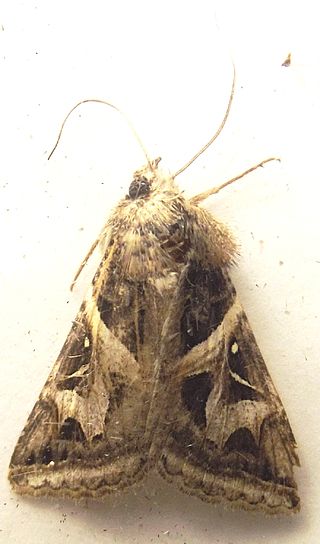
Ianius is a monotypic moth genus in the family Erebidae described by Richards in 1939. Its only species, Ianius mosca, was first described by Harrison Gray Dyar Jr. in 1910. It is found in Mexico and the southern United States, where it has been recorded from Texas.

Palpidia is a genus of moths in the family Erebidae. The genus was erected by Harrison Gray Dyar Jr. in 1898.
Eudeilinia is a genus of moths belonging to the subfamily Drepaninae.

Harrison Gray Dyar Jr. was an American entomologist. Dyar's Law, a pattern of geometric progression in the growth of insect parts, is named after him. He was also noted for eccentric pursuits which included digging tunnels under his home. He had a complicated personal life and along with his second wife he adopted the Baháʼí Faith.
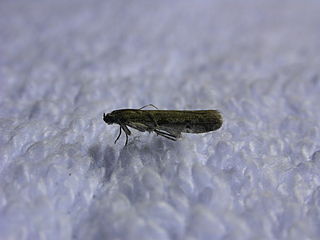
Phycitodes reliquella is a moth of the family Pyralidae described by Harrison Gray Dyar Jr. in 1904. It is known from North America where it is widely distributed in the east, including Alabama, Arkansas, Connecticut, the District of Columbia, Florida, Georgia, Illinois, Louisiana, Massachusetts, Maryland, Maine, North Carolina, New Hampshire, New Jersey, New York, Ohio, Oklahoma, Pennsylvania, South Carolina, Virginia and Ontario.

Eupithecia spermaphaga is a moth in the family Geometridae first described by Harrison Gray Dyar Jr. in 1917. It is found in western North America from British Columbia, through Oregon and Washington to Nevada and California.

Cosmosoma myrodora, the scarlet-bodied wasp moth, is a moth of the subfamily Arctiinae. It was described by Harrison Gray Dyar Jr. in 1907. It is found in the United States in Florida and from South Carolina to Texas. The habitat consists of coastal plains.
Spilosoma danbyi, or Danby's tiger moth, is a moth in the family Erebidae. It was described by Berthold Neumoegen and Harrison Gray Dyar Jr. in 1893. It is found in North America, where it has been recorded from Washington and western Canada from British Columbia to Manitoba.
Ornarantia dyari is a moth in the family Choreutidae. It was described by August Busck in 1900. It is found in Florida and on the Bahamas. The species name honors entomologist Harrison Gray Dyar Jr.
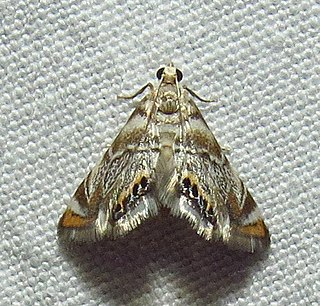
Eoparargyractis irroratalis is a moth in the family Crambidae. It was described by Harrison Gray Dyar Jr. in 1917. It is found in North America, where it has been recorded from Alabama, British Columbia, Florida, Georgia, Maryland, Montana and South Carolina.
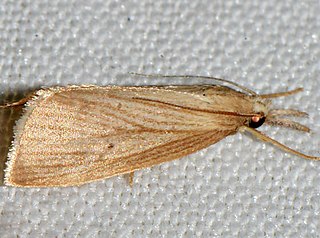
Diatraea evanescens is a moth in the family Crambidae. It was described by Harrison Gray Dyar Jr. in 1917. It is found in the US states of Alabama, Arkansas, Florida, Georgia, Louisiana, Maryland, Mississippi, North Carolina, Ohio, Oklahoma, South Carolina, Tennessee and Texas.
Donacaula nitidellus is a moth in the family Crambidae. It was described by Harrison Gray Dyar Jr. in 1917. It is found in North America, where it has been recorded from Alberta, Alabama, Connecticut, Georgia, Maryland, Massachusetts, Mississippi, New Jersey, New York, North Carolina, South Carolina and Texas.
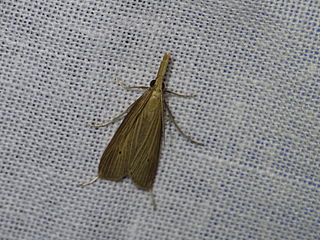
Donacaula roscidellus, the brown donacaula moth, is a moth in the family Crambidae. It was described by Harrison Gray Dyar Jr. in 1917. It is found in Mexico (Veracruz) and the United States, where it has been recorded from Florida, Kentucky, Louisiana, Mississippi and Texas.
Donacaula uxorialis is a moth in the family Crambidae. It was described by Harrison Gray Dyar Jr. in 1921. It is found in North America, where it has been recorded from Florida and Texas.
Leptosteges parthenialis is a moth in the family Crambidae. It was described by Harrison Gray Dyar Jr. in 1917. It has been recorded from the US states of Florida, Louisiana and Oklahoma.
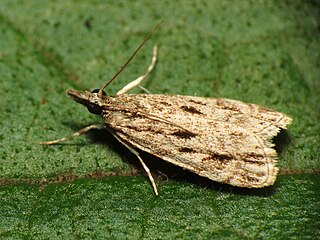
Eudonia strigalis, the striped eudonia moth, is a moth in the family Crambidae. It was described by Harrison Gray Dyar Jr. in 1906. It is found in North America, where it has been recorded from Nova Scotia to southern Ontario and south to Florida.

Paleacrita merriccata, the white-spotted cankerworm moth, is a moth of the family Geometridae. The species was first described by Harrison Gray Dyar Jr. in 1903. It is found in eastern North America, where it has been recorded from central Illinois, eastern Missouri, west-central Mississippi, Louisiana and eastern Texas.

Eudeilinia herminiata, the northern eudeilinia, is a moth in the family Drepanidae. It was described by Achille Guenée in 1857. It is found in North America, where it has been recorded from British Columbia to Newfoundland, south to Florida and west to Texas. The habitat consists of deciduous woods and wood edges.
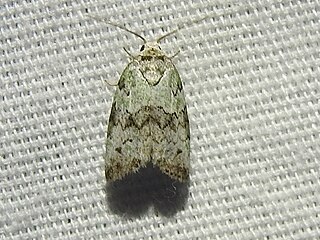
Afrida ydatodes, or Dyar's lichen moth, is a species of moth in the family Nolidae. It was described by Harrison Gray Dyar Jr. in 1913 and is found in North America, where it has been recorded from Alabama, Florida, Mississippi, North Carolina and Texas.













